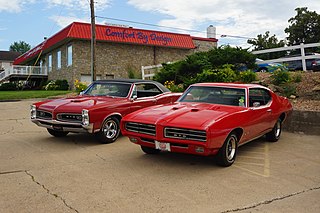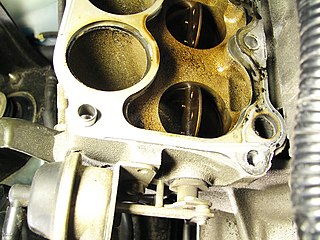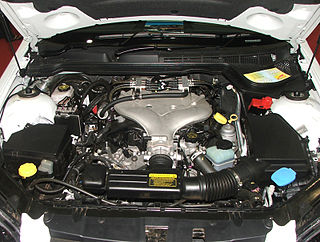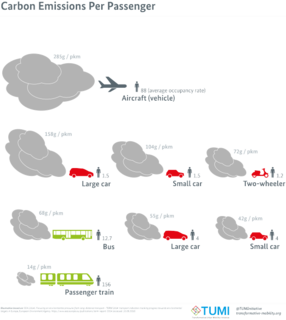Related Research Articles

The Pontiac GTO is an automobile that was manufactured by American automaker Pontiac from 1963 to 1974 for the 1964 to 1974 model years, and by GM's subsidiary Holden in Australia for the 2004 to 2006 model years.

The Porsche 930 is a sports car manufactured by German automobile manufacturer Porsche between 1975 and 1989, known to the public as the 911 Turbo. It was the maker's top-of-the-range 911 model for its entire production duration and, at the time of its introduction, was the fastest production car available in Germany.

The Porsche 993 is the internal designation for the Porsche 911 model manufactured and sold between January 1994 and early 1998, replacing the 964. Its discontinuation marked the end of air-cooled 911 models.

VTEC is a system developed by Honda to improve the volumetric efficiency of a four-stroke internal combustion engine, resulting in higher performance at high RPM, and lower fuel consumption at low RPM. The VTEC system uses two camshaft profiles and hydraulically selects between profiles. It was invented by Honda engineer Ikuo Kajitani. It is distinctly different from standard VVT systems which change only the valve timings and do not change the camshaft profile or valve lift in any way.

Porsche 997 is the internal designation for the Porsche 911 sports car manufactured and sold by German manufacturer Porsche between 2004 and 2012. Production of the Carrera and Carrera S coupés began in early 2004, all-wheel drive Carrera 4 and Carrera 4S began to be delivered to customers in November 2005, the Turbo and GT3 derivatives went on sale in late 2006 and the GT2 in 2007. In addition to the coupé and cabriolet versions, Targa versions of the Carrera 4 and Carrera 4S were also available, which carry on with the "glass canopy" roof design used since its first application on the 993 until the 991, which reverted to the classic targa top layout used on the early 911 Targas.

In internal combustion engines, a variable-length intake manifold (VLIM),variable intake manifold (VIM), or variable intake system (VIS) is an automobile internal combustion engine manifold technology. As the name implies, VLIM/VIM/VIS can vary the length of the intake tract - in order to optimise power and torque across the range of engine speed operation, as well as help provide better fuel efficiency. This effect is often achieved by having two separate intake ports, each controlled by a valve, that open two different manifolds - one with a short path that operates at full engine load, and another with a significantly longer path that operates at lower load. The first patent issued for a variable length intake manifold was published in 1958, US Patent US2835235 by Daimler Benz AG.

MIVEC is the brand name of a variable valve timing (VVT) engine technology developed by Mitsubishi Motors. MIVEC, as with other similar systems, varies the timing of the intake and exhaust camshafts which increases the power and torque output over a broad engine speed range while also being able to help spool a turbocharger more quickly and accurately.

The Ford Modular engine is Ford Motor Company's overhead camshaft (OHC) V8 and V10 gasoline-powered small block engine family. Despite popular belief that the Modular engine family received its moniker from the sharing of engine parts across numerous Ford vehicle platforms, in reality, the Modular engine family was named as such by Ford Motor Company for the new “modular approach” to the setup of tooling and casting stations in the Windsor and Romeo engine manufacturing plants.

The GM High Feature engine is a family of modern General Motors DOHC V6 engines. The series was introduced in 2004 with the Cadillac CTS and the Holden Commodore (VZ).

In automotive engineering, an exhaust manifold collects the exhaust gases from multiple cylinders into one pipe. The word manifold comes from the Old English word manigfeald and refers to the folding together of multiple inputs and outputs.

In automotive engineering, an inlet manifold or intake manifold is the part of an engine that supplies the fuel/air mixture to the cylinders. The word manifold comes from the Old English word manigfeald and refers to the multiplying of one (pipe) into many.

Reed valves are a type of check valve which restrict the flow of fluids to a single direction, opening and closing under changing pressure on each face. Modern versions often consist of flexible metal or composite materials.

Honda's first production V6 was the C series; it was produced in displacements from 2.0 to 3.5 liters. The C engine was produced in various forms for over 20 years (1985–2005), having first been used in its then new Legend model, and its British sister car the Rover 800-series.

The Chrysler Hemi engines, known by the trademark Hemi, are a series of I6 and V8 gasoline engines built by Chrysler with hemispherical combustion chambers. Three different types of Hemi engines have been built by Chrysler for automobiles: the first from 1951 to 1958, the second from 1964 to 1971, and the third beginning in 2003. Although Chrysler is most identified with the use of "Hemi" as a marketing term, many other auto manufacturers have incorporated similar designs.

The Honda K-series engine is a line of four-cylinder four-stroke car engine introduced in 2001. The K-series engines are equipped with DOHC valvetrains and use roller rockers to reduce friction. The engines use a coil-on-plug, distributorless ignition system with a coil for each spark plug. This system forgoes the use of a conventional distributor-based ignition timing system in favor of a computer-controlled system that allows the ECU to control ignition timings based on various sensor inputs. The cylinders have cast iron sleeves similar to the B- and F-series engines, as opposed to the FRM cylinders found in the H- and newer F-series engines found only in the Honda S2000.

The Proton CamPro engine is the first flagship automotive engine developed together with Lotus by the Malaysian automobile manufacturer, Proton.

The Subaru EJ engine is a series of four-stroke automotive engines manufactured by Subaru. They were introduced in 1989, intended to succeed the previous Subaru EA engine. The EJ series is the mainstay of Subaru's engine line, with all engines of this series being 16-valve horizontal flat-fours, with configurations available for single, or double-overhead camshaft arrangements. Naturally aspirated and turbocharged versions are available, ranging from 96 to 320 hp. These engines are commonly used in light aircraft, kit cars and engine swaps into air-cooled Volkswagens, and are also popular as a swap into copy wasserboxer engined Volkswagen T3/Vanagon . Primary engineering on the EJ series was done by Masayuki Kodama, Takemasa Yamada and Shuji Sawafuji of Fuji Heavy Industries, Subaru's parent company.

Energy-efficient driving techniques are used by drivers who wish to reduce their fuel consumption, and thus maximize fuel efficiency. The use of these techniques is called "hypermiling".

The Porsche 991 is the internal designation for the seventh generation of the Porsche 911 sports car, which was unveiled at the 2011 Frankfurt Motor Show on 15 September as the replacement for the 997. The 991 was an entirely new platform, only the third since the original 911 launched in 1963. Production of the 991 generation ended on December 20, 2019, with 233,540 units produced.

The Porsche 911 is a two-door, 2+2 high performance rear-engined sports car. Introduced in September 1964 by Porsche AG of Stuttgart, Germany. It has a rear-mounted flat-six engine and all round independent suspension. It has undergone continuous development, though the basic concept has remained unchanged. The engines were air-cooled until the introduction of the Type 996 in 1998, with the 993, produced from 1994–1998 model years, being the last of the air-cooled Porsche sports cars.
References
- ↑ VarioRAM Explained at the Wayback Machine (archived 8 August 2013)
- ↑ "How and why a VarioRAM works". instant-g.com. Retrieved 2018-08-01.
- ↑ "Technology explained: VarioRam". total911.com. Retrieved 2018-08-01.
- ↑ "October 1995: A new Targa, Varioram and more join the 911 lineup". autoweek.com. Retrieved 2018-08-01.
| | This article about an automotive technology is a stub. You can help Wikipedia by expanding it. |